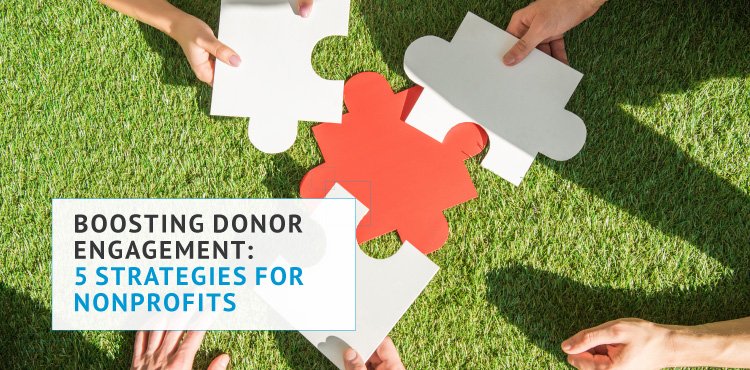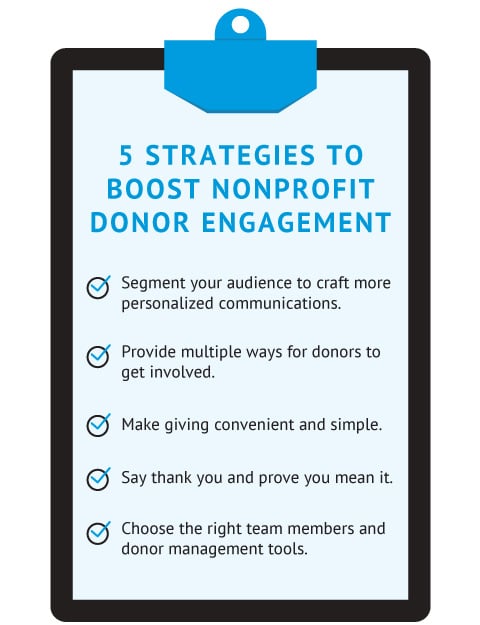
In the nonprofit world, the average donor retention rate, or the percentage of donors who continue to give year after year, has been in a steady decline. According to AFP’s Fundraising Effectiveness Project, the average donor retention rate was 30.7% percent in the third quarter of 2023. For context, the average donor retention just three years earlier in 2020 was 43.6%.
While donor retention varies year to year and from organization to organization, such a steep drop in retention should serve as a sign that your nonprofit needs to stay on top of its relationship-building efforts in order to secure funding for its mission.
Retaining your donors is similar to retaining employees. In both cases, you want to make each individual feel like an indispensable part of your organization. One of the best ways to do this is to prioritize donor engagement, the ways in which you connect and build relationships with your donors and keep them interested and involved in your work. To help, we’ve curated a list of five strategies you can use.
To better engage donors, you should:
- Segment your audience to craft more personalized communications.
- Provide multiple ways for donors to get involved.
- Make giving convenient and simple.
- Say thank you and prove you mean it.
- Choose the right team members and donor management tools.

1. Segment your audience to craft more personalized communications.
Begin strengthening your donor engagement strategy by learning more about your donors and using that information to improve your interactions with them.
Your donor database should maintain accurate information about your donor pool, like demographics, giving history and frequency, communication preferences, and more. If it’s been a while since you’ve revisited your data, you may need to update it or have it appended to fill in any gaps.
You can then use this information to segment your donors. Segmentation is the process of grouping donors based on shared characteristics, which can then help you tailor your marketing messages and fundraising appeals to each group accordingly.
Here are some examples of how you might segment your donors:
- By history of involvement: Group donors based on how frequently they contribute to your cause or how long they’ve been involved with your cause. For example, you could create a segment of monthly donors and send them messages thanking them for their recurring support. Or, you could send introductory messages to new donors to welcome them to your organization.
- By giving type: Donors range in their giving amounts as well as their giving preferences. Segmenting by giving-specific characteristics allows you to thank donors properly and send them information about campaigns they’d likely be interested in.
- By communication preference: Everyone likes to be communicated with in a way that resonates with them. For instance, you might find your younger donors prefer connecting via social media while older donors prefer email or direct mail outreach. Segmentation by communication preference allows you to meet your donors where they are and makes it more likely that they’ll actually read and respond to your messages.
Segmenting donors and sending relevant communications to each group shows your supporters that you’ve taken the time to get to know them as individuals and take their preferences into account. This can generate goodwill among donors, leading to greater engagement and, eventually, continued support for your cause.
2. Provide multiple ways for donors to get involved.
If you only ever reach out to donors looking for additional donations, they’ll likely start to feel more like walking ATMs than valued members of your organization’s community.
On the other hand, when you reach out to supporters to promote a wide range of involvement opportunities, you can pique their interest and show them that your organization values non-monetary contributions, too.
Invite donors to participate in activities like:
- Volunteer opportunities: Give donors a chance to take on a more hands-on role through volunteering. Volunteering can give donors greater insight into the impacts of their donations and strengthen the emotional bonds between supporters and your nonprofit.
- Peer-to-peer (P2P) fundraising: With P2P fundraising, your supporters fundraise on behalf of your organization. Using P2P fundraising software, they set up their own donation pages and share them with their family members and friends. This can be a fun way to not just engage your current donors but also connect with new donors!
- Advocacy: Your organization is likely engaged in ongoing advocacy efforts, whether it’s lobbying at your state’s capitol or using social media to raise awareness of an issue. Share information about these efforts with your donors to bring them into the advocacy side of your cause. Many donors will be interested in signing petitions, contacting their representatives, or sharing information about your mission on their social media pages.
As you work to promote various involvement opportunities to your donors, remember to take into account their personal preferences and interests. Some donors, for example, may be excited at the prospect of fundraising for your cause during a P2P campaign, while others may prefer a more low-key volunteer opportunity.
3. Make giving convenient and simple.
If you want your donors to continue giving again and again, your donation process needs to be quick, easy, and convenient. Here are a few tips for improving the quality of your organization’s giving experience and encouraging donors to make multiple contributions:
- Maintain a well-organized website. Your website should be easy to navigate and offer a great user experience. Ensure it has a simple navigation menu, uncluttered design with plenty of white space, and large and easy-to-click buttons that point your visitors to your donation form.
- Streamline your online donation page. It should be easy and simple to fill out the form on your donation page. Be sure to only ask for necessary information on the page and accept multiple payment types.
- Offer a recurring gift option. Recurring or monthly gifts provide a steady stream of revenue for your organization. Plus, by adding a recurring gift option to your giving page, you offer greater convenience to donors who want to consistently support you. They’ll only have to enter their information once and then the donation amount will be automatically transferred from their account on a recurring basis.
- Educate your donors about matching gifts. Corporate matching gift programs empower donors to double, triple, or sometimes quadruple their contributions without reaching back into their wallets. The problem is, most donors don’t know if their employer offers a matching gift program. Educate your donors about matching gifts and empower them to check their eligibility by embedding a matching gift database on your donation page.
It would be a shame to inadvertently turn potential repeat donors away because your giving process is too complex, long, or confusing. Ensure every aspect of the process is tailored to donors’ needs and offers simplicity and convenience.
4. Say thank you and prove you mean it.
Some of the greatest contributors to low donor retention rates are donors not feeling appreciated for their contributions or not knowing the impact of their gifts.
By failing to follow up with donors after they give, they may feel overlooked or like their gift doesn’t even matter to your organization. Of course, you know this isn’t the case—donors’ involvement provides the funding you need to continue helping people and working toward your mission. You must convey your gratitude for this support using strategic appreciation efforts.
Here are a few tips for doing so:
- Personalize your thank-you messages. In your thank yous, use your donors’ preferred names and reference their specific contributions. For instance, your message could say something like, “Dear Emily, Thank you for your contribution of $100 to our holiday fundraiser!”
- Show the impact of their gifts. Donors want and deserve to know how their donations made a difference for your cause. Be specific in sharing their impact. For instance, you might say, “Your gift helped purchase enough supplies to provide a holiday meal and gifts for two families.”
- Ask for donors’ feedback. Show that you care about your donors’ experiences by asking about what your organization should keep doing and what it can improve on. This will help donors feel like true partners in achieving your mission. Ask donors for feedback on aspects of your operations like your social media presence, how you’re using AI in your fundraising work, or communication frequency. Better yet, take that feedback to heart and act on it!
Be prompt in sending thank-you messages right after your donors give, and take your appreciation efforts a step further by highlighting donors on your website, email newsletter, or social media accounts.
5. Choose the right team members and donor management tools.
Your nonprofit can only carry out effective donor engagement strategies if you have the support of a strong team and the right donor management resources. After all, how can you properly engage donors if your internal team isn’t unified and made up of talented people?
Ensure your team is aligned and has the tools it needs to be successful by following these tips:
Hire the right people.
As you hire new employees to build your team, keep an eye out for those who have experience managing donor relationships. Specify in your organization’s job postings that you want your team members to be comfortable with reaching out to donors, building relationships, and extending fundraising asks.
Even if candidates don’t have any specific donor management experience, they still might be effective fundraising team members if they’re organized, outgoing, flexible, and passionate about your cause. Look for these attributes during the interview process.
If your organization has historically struggled with finding the right job candidates or reducing your turnover rate, it might be time to hire an expert like an HR consultant to help. Astron Solutions’ guide to HR consulting firms explains that these professionals can help develop strategies for better employee recruitment and retention and equip you to create compensation packages that increase your appeal.
Rely on the right tools and resources.
It’s not only important that your team is made up of engaged, hard working people, but that you give your team members the resources and tools they need to confidently lead their roles.
When it comes to donor engagement, you’ll need tools on your side like:
As you build up or add to your toolbox, remember to take into account your supporter’s specific engagement needs and expectations, as well as the budget you have to work with.
To ensure that you can retain consistent support for your nonprofit’s cause over time, you need to become well-versed in the art of donor engagement. In this short guide, we’ve outlined some actionable strategies you can use to improve your current approach to engagement. Remember to strengthen your internal team and toolbox, and to pay close attention to what you know about your donors. You’ve got this!